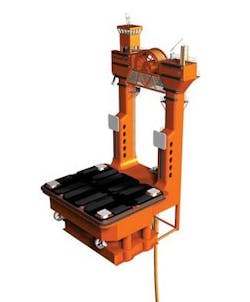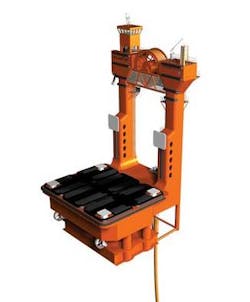Offloading technique offers improved uptime in all water depths
Construction is under way on the first HiLoad DP offshore loading system. The work is being handled by Aibel (formerly Vetco Aibel) at its Haugesund yard in western Norway, with Grenland Group responsible for detailed engineering. Delivery is scheduled for summer 2008.
Remora ASA, the owner of the technology, is working to get a contract in place for the first unit. HiLoad DP lends itself best to a shipping model, and for that reason the company proposes leasing out the system on a time charter basis, according to Frode Berg, CEO of Hitec Industries and a Remora director. Hitec raised NKr 420 million ($68 million) to finance construction of the first unit through a share issue which brought in 37 new owners. As a result, it has scaled back its interest in Remora from 100% to 21.8%.
High friction force
HiLoad DP is a dynamically positioned offshore vessel, with an L-shape, which gives it a unique appearance. It consists of a pontoon with a keel and two slim towers at either side of the stern. On the upper surface of the pontoon is a friction attachment system, by means of which the vessel attaches itself to the underside of the loading tanker.
The vessel weighs 4,000 metric tons (4,409 tons) and measures 50 m (164 ft) from the top of the towers to the bottom of the keel. The surface area of the pontoon is 27 m x 28 m (89 ft x 92 ft), giving around 500 sq m (5,382 sq ft) of friction area. The force of attachment is equivalent to the hydrostatic pressure applied by the sea on the same area of hull, providing a corresponding friction force of 6,000 metric tons (6,614 tons), according to Tore Lea, Remora CEO.
The offloading hose from the production facility, be it an FPSO or fixed platform, is permanently attached to the HiLoad unit. The end section of the offloading system is a spooled length of hose which, once the unit is attached to the tanker, becomes unreeled and connected to the tanker’s midships loading manifold.
While loading is taking place, HiLoad DP uses its powerful DP Class II system, with three thrusters and three diesel engines generating 11,000 hp, to take over station-keeping for the tanker. It can do this for tankers up to VLCC size. Rotation of the tanker through 360° is possible, as HiLoad DP is fitted with a swivel to ensure that the offloading hose does not get twisted.
Wave tests
An important milestone for the development came in January, when scale model testing of the final design at Marintek’s Ocean Basin facility in Trondheim showed that HiLoad could dock to a tanker in significant wave heights of up to 4.5 m (14.8 ft). It also performed satisfactorily in survival tests simulating the extreme conditions encountered during Hurricane Katrina. The test program indicated that HiLoad could operate with close to 100% operational regularity in areas like the Gulf of Mexico, West Africa and Brazil, and with the same regularity as DP II tankers in the North Sea.
The system thereby offers advantages over alternatives such as tandem loading from a spread-moored or turret-moored FPSO, or loading through a CALM buoy. These methods involve a spread of tugs, which are subject to operational restrictions, and are unable to operate in significant wave heights of more than about 1.5-2 m (5-7 ft) or during the hours of darkness. For CALM buoy operations a line-boat is also required.
HiLoad DP, which requires only a crew of two DP operators, offers a reduction in operating costs by eliminating the need for tugboats and line-boats, and also reduces capex as there is no need for a tanker mooring system. It can operate around the clock and requires no modifications to either the tanker or the FPSO. But probably the most important benefit is that it offers a considerable improvement in export regularity, says Lea. The system is also quite independent of water depth, making it especially attractive in deepwater areas.
As HiLoad DP can be used with tankers of opportunity, it avoids the needs for tankers to be equipped with a DP system, as is the case in the North Sea and to some extent in Brazil.
The initial idea for HiLoad surfaced in the late 1990s, and the extensive qualification program required to develop it into commercial technology began in 2000. A valuable contribution was made in the early stages by Conoco Marine, and the technology was considered proven following a full verification and Hazid review by Total in 2005.
The main equipment for the first unit, including diesel engines from Caterpillar, thrusters from Wärtsilä, a DP system from Kongsberg and a hose handling system from Aker Kvaerner Pusnes, is considered off-the-shelf, says Lea. This is in line with Remora’s operational philosophy of using standard and proven equipment, such that spare parts are available within 24 hours anywhere in the world. All maintenance can be carried out at sea - there is no need for drydocking the unit.
Other applications of the HiLoad principle include a moored turret version, which is aimed at permanently stationed vessels such as FPSOs and floating storage units, and as an attachable propulsion and/or DP unit.
Another application, as an LNG regasification terminal, has been spun off into a separate company, Torp, which is a Hitec Industries subsidiary.

